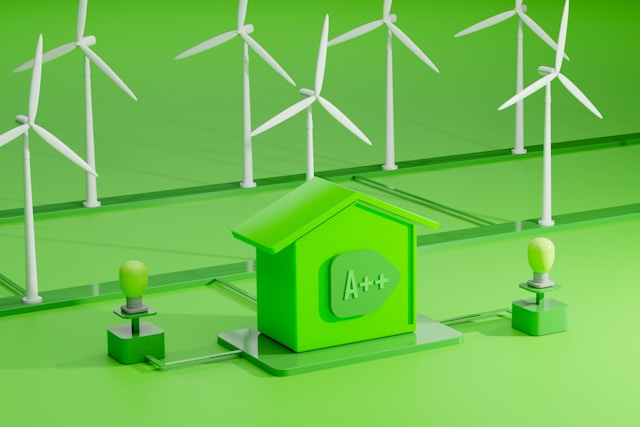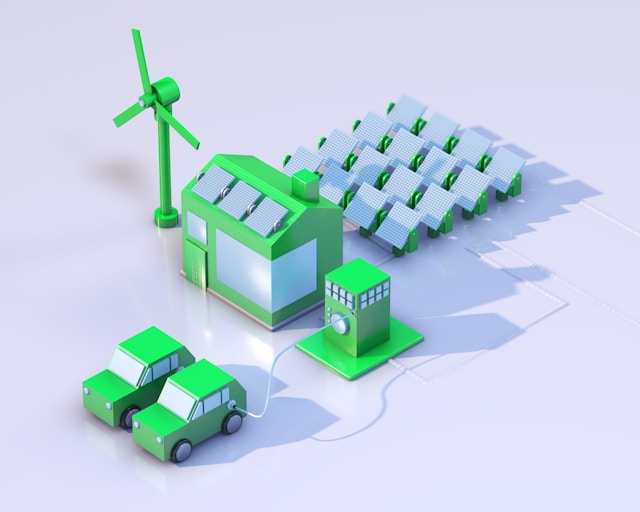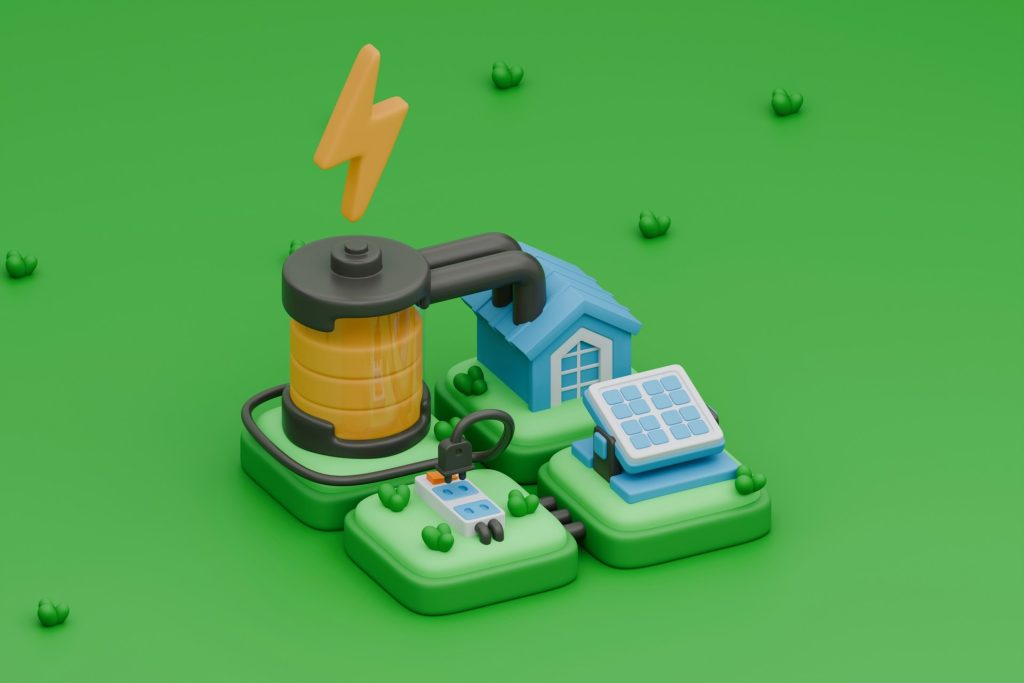Hey there, eco-warriors! Today, we’re diving into an exciting topic that’s buzzing in both the tech and environmental spheres: green technology and its impact on big industries. Let’s explore how innovative eco-tech is transforming major sectors, helping us pave the way toward a more sustainable future.
The Rise of Green Tech
Green technology, also known as clean technology or eco-tech, has emerged as a game-changer in recent years, capturing the imagination of industries and individuals alike. This rise isn’t just a fleeting trend; it’s a significant shift in how we approach our relationship with the environment. Let’s dive deeper into why green tech is gaining traction and how it’s setting the stage for a more sustainable future.
Understanding Green Tech
Green technology encompasses a broad range of innovations designed to mitigate the environmental impact of human activities. These include renewable energy sources like solar, wind, and hydropower, energy-efficient products and buildings, sustainable agriculture practices, waste management solutions, and much more. The goal is to create systems that are not only less harmful to the environment but also regenerative and restorative.
The Drivers Behind Green Tech
Several factors are driving the rise of green tech:
-
Environmental Awareness: There’s a growing recognition of the environmental challenges we face, such as climate change, pollution, and resource depletion. This awareness has spurred demand for solutions that can help mitigate these issues.
-
Government Policies and Incentives: Many governments worldwide are implementing policies and incentives to promote green technology. For example, subsidies for renewable energy projects, tax breaks for energy-efficient appliances, and stringent regulations on emissions are all encouraging the adoption of eco-friendly technologies.
-
Technological Advancements: Rapid advancements in technology have made green solutions more viable and cost-effective. For instance, the cost of solar panels has plummeted over the past decade, making solar energy more accessible to businesses and homeowners.
-
Economic Benefits: Green technology often leads to cost savings in the long run. Energy-efficient buildings and renewable energy sources can significantly reduce utility bills, while sustainable agricultural practices can increase crop yields and reduce input costs.
-
Consumer Demand: Consumers are becoming more environmentally conscious and are demanding greener products and services. This shift in consumer behavior is pushing companies to adopt sustainable practices to meet market expectations.
Key Areas of Green Tech Development
Let’s take a closer look at some of the key areas where green tech is making waves:
Renewable Energy
Renewable energy is perhaps the most visible aspect of green tech. Solar and wind power have seen incredible growth due to their decreasing costs and increasing efficiency. Innovations like floating solar farms, offshore wind turbines, and advanced battery storage systems are pushing the boundaries of what’s possible.
Energy Efficiency
Energy efficiency is about doing more with less energy. From LED lighting and smart thermostats to energy-efficient appliances and green buildings, there are countless ways to reduce energy consumption. For example, the development of smart grids allows for better management and distribution of electricity, reducing waste and improving reliability.
Sustainable Agriculture
Sustainable agriculture practices aim to produce food in ways that are environmentally friendly and economically viable. Precision farming uses GPS and IoT technologies to optimize field-level management concerning crop farming. Organic farming, permaculture, and agroforestry are other methods gaining popularity for their sustainable approach.
Green Manufacturing
Green manufacturing involves using processes that reduce pollution, conserve energy and natural resources, and are economically sound and safe for workers. Advances in recycling technologies and the development of biodegradable materials are crucial components of this area.
Clean Transportation
The transportation sector is undergoing a green revolution with the rise of electric vehicles (EVs), hydrogen fuel cells, and biofuels. Public transportation systems are also being revamped to become more sustainable, with electric buses and trains becoming more common.
Waste Management
Effective waste management is essential for reducing the environmental impact of human activities. Innovations in recycling, composting, and waste-to-energy technologies are helping to minimize waste and turn it into valuable resources.
The Future of Green Tech
The future of green tech looks promising. With continuous advancements and increasing adoption, we can expect even more innovative solutions to emerge. Companies across various industries are investing heavily in research and development to create products and processes that are not only environmentally friendly but also economically beneficial.
The rise of green tech signifies a fundamental shift in how we approach development and progress. By prioritizing sustainability and environmental responsibility, we can create a world where economic growth and environmental stewardship go hand in hand.

Green Tech in Energy
When it comes to green technology, the energy sector stands out as a leader in adopting innovative solutions to tackle environmental challenges. The shift from fossil fuels to renewable energy sources is a critical part of our journey towards sustainability. Let’s dive deeper into how green tech is revolutionizing the energy industry and reshaping our approach to power generation and consumption.
Solar Power
Solar power has seen tremendous growth over the past few decades. Advances in photovoltaic (PV) technology have dramatically increased the efficiency and affordability of solar panels. Modern solar panels can convert sunlight into electricity with impressive efficiency, making solar power a viable option for homes, businesses, and even large-scale power plants.
One of the key developments in solar technology is the creation of solar farms. These large-scale installations can generate significant amounts of electricity, often supplying power to entire communities. Innovations like floating solar farms, which are installed on bodies of water, are expanding the potential locations for solar energy production and reducing the need for valuable land space.
Moreover, solar power is becoming more accessible to individuals. Companies like Tesla offer solar panels and solar roofs that allow homeowners to generate their own electricity, reducing reliance on the grid and cutting energy costs. Additionally, community solar programs enable people who cannot install their own panels to buy into shared solar projects.
Wind Energy
Wind energy is another major player in the renewable energy landscape. Wind turbines, which convert the kinetic energy of wind into electricity, have become a common sight in many parts of the world. Technological advancements have led to the development of larger and more efficient turbines, capable of generating substantial amounts of electricity even in lower wind conditions.
Offshore wind farms are a particularly exciting development in this field. By placing wind turbines in the ocean, where winds are typically stronger and more consistent, these farms can produce large amounts of energy without taking up valuable land space. Countries like Denmark and the United Kingdom are leading the way in offshore wind energy, with projects like the Hornsea Wind Farm, which is one of the largest in the world.
Hydropower
Hydropower has been a reliable source of renewable energy for over a century. By harnessing the power of moving water, hydropower plants generate electricity with minimal greenhouse gas emissions. Traditional hydropower involves the construction of large dams, but new innovations are making it possible to generate power from smaller, less intrusive projects.
For example, run-of-the-river hydropower systems generate electricity without the need for large reservoirs, reducing the environmental impact and allowing for the continued flow of rivers. Micro-hydro systems are another innovation, providing sustainable power to remote communities without access to the national grid.
Geothermal Energy
Geothermal energy taps into the Earth’s natural heat to generate electricity and provide heating. This renewable energy source is both reliable and sustainable, with the potential to supply base-load power—electricity that is available 24/7, regardless of weather conditions.
Countries like Iceland and New Zealand have successfully harnessed geothermal energy for decades. In recent years, advancements in drilling technology and heat extraction methods have made geothermal energy more accessible in other parts of the world. Enhanced geothermal systems (EGS) are a promising development, allowing us to exploit geothermal resources in areas where traditional methods were not feasible.
Energy Storage
One of the biggest challenges with renewable energy sources like solar and wind is their intermittent nature—they don’t always produce electricity when demand is highest. Energy storage technologies are crucial for overcoming this hurdle, allowing us to store excess energy generated during peak production times and use it when production is low.
Battery technology has seen significant advancements, with lithium-ion batteries becoming the standard for energy storage. Companies like Tesla and LG Chem are developing high-capacity batteries that can store energy for homes, businesses, and even entire communities.
In addition to batteries, other storage solutions like pumped hydro storage, compressed air energy storage, and thermal storage are being explored and implemented. These technologies are essential for creating a reliable and resilient energy grid that can fully integrate renewable energy sources.
Smart Grids
Smart grids are modern electricity networks that use digital technology to monitor and manage the distribution of electricity. By incorporating smart meters, sensors, and advanced analytics, smart grids can optimize the flow of electricity, reduce waste, and improve reliability.
One of the key benefits of smart grids is their ability to integrate renewable energy sources more effectively. By managing supply and demand in real-time, smart grids can balance the intermittent nature of renewables, ensuring a stable and consistent power supply. Additionally, smart grids can facilitate demand response programs, where consumers are incentivized to reduce or shift their electricity use during peak times.
The energy sector’s transformation through green technology is a crucial step towards a sustainable future. By harnessing renewable energy sources, improving energy efficiency, and developing innovative storage solutions, we are reducing our dependence on fossil fuels and minimizing our environmental impact. This shift is not only beneficial for the planet but also offers economic advantages, creating jobs and stimulating technological innovation.

Green Tech in Transportation
Transportation is undergoing a significant transformation thanks to green technology. With increasing concerns about climate change, pollution, and the sustainability of our transportation systems, green tech is stepping in to provide innovative solutions. From electric vehicles to high-speed rail, let’s explore how green technology is revolutionizing the way we move.
Electric Vehicles (EVs)
Electric vehicles are at the forefront of the green transportation revolution. EVs run on electricity instead of gasoline or diesel, drastically reducing greenhouse gas emissions and air pollution. Companies like Tesla, Nissan, and Chevrolet are leading the charge with a variety of EV models that cater to different needs and budgets.
EV technology has come a long way, with significant improvements in battery life, charging speed, and driving range. The introduction of fast-charging networks, such as Tesla’s Supercharger network, allows EV owners to charge their cars quickly and conveniently, making long-distance travel more feasible.
Moreover, governments worldwide are offering incentives to encourage the adoption of EVs. These incentives include tax credits, rebates, and access to carpool lanes, making EVs an attractive option for consumers.
Hybrid Vehicles
While fully electric vehicles are gaining popularity, hybrid vehicles remain an essential part of the transition to greener transportation. Hybrids combine a traditional internal combustion engine with an electric motor, offering improved fuel efficiency and reduced emissions compared to conventional vehicles.
Manufacturers like Toyota and Honda have been at the forefront of hybrid technology, producing popular models such as the Prius and Insight. These vehicles provide a practical solution for those who may not have access to charging infrastructure but still want to reduce their environmental impact.
Hydrogen Fuel Cell Vehicles
Hydrogen fuel cell vehicles (FCVs) represent another promising avenue for green transportation. FCVs generate electricity by combining hydrogen and oxygen in a fuel cell, emitting only water vapor as a byproduct. This technology offers the benefits of fast refueling and long driving ranges, similar to traditional gasoline vehicles.
Companies like Toyota and Honda are pioneering hydrogen fuel cell technology with models like the Mirai and Clarity. While the infrastructure for hydrogen refueling is still developing, the potential for a zero-emission transportation future makes FCVs an exciting prospect.
Public Transportation
Public transportation systems are also embracing green technology to reduce emissions and improve efficiency. Electric buses, for example, are becoming increasingly common in cities worldwide. These buses produce zero tailpipe emissions and offer quieter, smoother rides compared to their diesel counterparts.
Companies like Proterra and BYD are leading the development of electric buses, providing solutions that help cities meet their sustainability goals. Additionally, advancements in battery technology and charging infrastructure are making electric buses more viable for widespread adoption.
Light rail and metro systems are also incorporating green technologies. Energy-efficient trains, regenerative braking systems, and renewable energy-powered stations are just a few examples of how public transportation is going green. Cities like Copenhagen and Amsterdam are investing in extensive cycling infrastructure, promoting cycling as a sustainable and healthy alternative to car travel.
High-Speed Rail
High-speed rail is another area where green tech is making a significant impact. High-speed trains, powered by electricity, offer a fast and efficient alternative to air travel for medium-distance trips. Countries like Japan, France, and China have developed extensive high-speed rail networks, significantly reducing the need for short-haul flights and cutting down on associated emissions.
The environmental benefits of high-speed rail are substantial. Trains are more energy-efficient than cars and planes, and with the potential to run on renewable energy, they offer a sustainable solution for mass transportation. The development of high-speed rail in regions like California and the European Union demonstrates the growing commitment to sustainable travel options.
Shared Mobility
Shared mobility services, such as car-sharing, bike-sharing, and ride-hailing, are also contributing to the green transportation movement. These services reduce the need for individual car ownership, leading to fewer cars on the road and lower overall emissions.
Companies like Zipcar, Lyft, and Uber are integrating green technology into their fleets, offering electric and hybrid vehicles as part of their services. Bike-sharing programs, available in many cities worldwide, provide an eco-friendly alternative for short trips, reducing the reliance on cars for urban transportation.
Autonomous Vehicles
Autonomous vehicles (AVs) have the potential to revolutionize transportation by improving efficiency and reducing emissions. Self-driving technology can optimize driving patterns, reduce congestion, and promote the use of electric vehicles.
Companies like Waymo, Tesla, and Cruise are at the forefront of autonomous vehicle development. While fully autonomous vehicles are still in the testing phase, their integration with green technology promises a future where transportation is not only more convenient but also more sustainable.
Green technology is transforming the transportation sector, offering sustainable solutions that reduce emissions, improve efficiency, and promote cleaner travel. From electric and hybrid vehicles to high-speed rail and shared mobility services, the future of transportation is undeniably green.

Green Tech in Manufacturing
The manufacturing sector is a cornerstone of the global economy, producing the goods and materials that sustain our daily lives. However, traditional manufacturing processes have often been resource-intensive and environmentally damaging. Enter green technology—innovations designed to make manufacturing more sustainable, efficient, and less harmful to the planet. Let’s delve into how green tech is transforming manufacturing.
Sustainable Materials
One of the most impactful ways green technology is influencing manufacturing is through the development and use of sustainable materials. These materials are designed to minimize environmental impact, both in their production and throughout their lifecycle.
Recycled Materials: Using recycled materials reduces the need for virgin resources and decreases waste. Companies like Interface, a global flooring manufacturer, are leading the way by using recycled materials in their products. Interface has set ambitious goals to eliminate their environmental footprint, using recycled nylon from old carpets and discarded fishing nets in their flooring products.
Biodegradable Materials: Biodegradable materials break down naturally, reducing landfill waste and pollution. For instance, biodegradable plastics made from plant-based materials like corn starch or sugarcane are becoming more common. Companies like NatureWorks are producing Ingeo, a type of bioplastic made from renewable resources that decompose more quickly than traditional plastics.
Alternative Building Materials: In construction, sustainable alternatives like bamboo, recycled steel, and reclaimed wood are gaining popularity. These materials not only reduce the environmental impact of new buildings but also often provide improved durability and aesthetics.
Energy Efficiency
Improving energy efficiency is a crucial aspect of green tech in manufacturing. By reducing the amount of energy required for production, manufacturers can significantly cut their carbon emissions and lower operational costs.
Efficient Machinery: Modern manufacturing equipment is designed to be more energy-efficient. For example, electric injection molding machines use less energy than their hydraulic counterparts. Innovations in motor technology, such as variable speed drives, allow machines to operate more efficiently by adjusting the power output to match the workload.
Smart Manufacturing: The advent of Industry 4.0 technologies, including the Internet of Things (IoT), artificial intelligence (AI), and machine learning, enables smart manufacturing. These technologies optimize production processes, reduce waste, and improve energy management. For instance, predictive maintenance systems can monitor machinery in real-time and predict failures before they occur, reducing downtime and energy consumption.
Green Buildings: Manufacturing facilities themselves are becoming more energy-efficient. Green building standards, such as LEED (Leadership in Energy and Environmental Design) and BREEAM (Building Research Establishment Environmental Assessment Method), encourage the construction of energy-efficient factories. Features like improved insulation, natural lighting, and renewable energy systems (solar panels, wind turbines) reduce the energy footprint of manufacturing plants.
Waste Reduction
Reducing waste is another significant area where green technology is making a difference in manufacturing.
Zero-Waste Initiatives: Many companies are adopting zero-waste policies, aiming to send no waste to landfills. This involves reducing waste generation, reusing materials, and recycling. For example, Toyota has implemented zero-waste practices in several of its plants, achieving nearly zero landfill waste by reusing and recycling materials.
Circular Economy: The circular economy model focuses on designing products and processes that allow materials to be reused, refurbished, and recycled indefinitely. Companies like Patagonia are pioneering this approach by creating durable products, offering repair services, and encouraging customers to return old items for recycling.
Additive Manufacturing: Also known as 3D printing, additive manufacturing creates products by adding material layer by layer, which contrasts with traditional subtractive methods that remove material. This process reduces waste significantly. For example, General Electric uses 3D printing to produce aircraft engine parts, reducing material waste and improving efficiency.
Renewable Energy Integration
Incorporating renewable energy sources into manufacturing processes is another way green tech is transforming the industry.
On-Site Renewable Energy: Many manufacturing facilities are installing renewable energy systems to generate their own power. Solar panels, wind turbines, and even bioenergy systems can be integrated into factory sites to provide a significant portion of the required energy. For instance, Tesla’s Gigafactory in Nevada is powered by a combination of solar, wind, and geothermal energy, aiming for a net-zero energy status.
Power Purchase Agreements (PPAs): Manufacturers can also invest in off-site renewable energy through power purchase agreements. This involves buying renewable energy from external sources, supporting the development of renewable energy projects, and reducing the carbon footprint of manufacturing operations. Companies like Apple have used PPAs to power their operations with 100% renewable energy.
Sustainable Supply Chain Management
Green technology is also revolutionizing supply chain management by promoting sustainability throughout the entire lifecycle of products, from raw material extraction to end-of-life disposal.
Supply Chain Transparency: Technologies like blockchain are being used to improve supply chain transparency. By tracking materials and products through every stage of the supply chain, companies can ensure that they are sourcing from environmentally responsible suppliers. For example, Everledger uses blockchain to trace the origins of diamonds, ensuring they are ethically sourced.
Eco-Friendly Logistics: Green logistics practices aim to reduce the environmental impact of transporting goods. This includes optimizing routes to reduce fuel consumption, using electric or hybrid delivery vehicles, and improving packaging to reduce waste. Companies like UPS are investing in alternative fuel vehicles and optimizing delivery routes to cut emissions.
Water Conservation
Water is a critical resource in many manufacturing processes. Green tech is helping companies reduce water usage and improve water quality.
Water Recycling and Reuse: Technologies for treating and recycling wastewater allow manufacturers to reuse water in their processes. This not only conserves water but also reduces the environmental impact of wastewater discharge. For example, Intel has implemented water recycling systems in its semiconductor manufacturing plants, significantly reducing freshwater consumption.
Efficient Water Use: Advanced monitoring and control systems help optimize water usage in manufacturing processes. For instance, precision irrigation in agricultural manufacturing reduces water usage by delivering the exact amount of water needed.
Green technology is revolutionizing the manufacturing sector, making it more sustainable, efficient, and environmentally friendly. From sustainable materials and energy efficiency to waste reduction and renewable energy integration, green tech is driving a paradigm shift in how we produce goods.
Conclusion
As we’ve seen, green technology is influencing big industries in profound ways. By embracing these innovations, companies are not only reducing their environmental impact but also reaping economic benefits. It’s a win-win situation for businesses and the planet.
So, whether you’re an eco-tech enthusiast or a business owner looking to go green, there’s never been a better time to dive into the world of green technology. Let’s continue to support and develop these innovations, making our industries—and our world—more sustainable for generations to come.
Stay green and tech-savvy, everyone!


